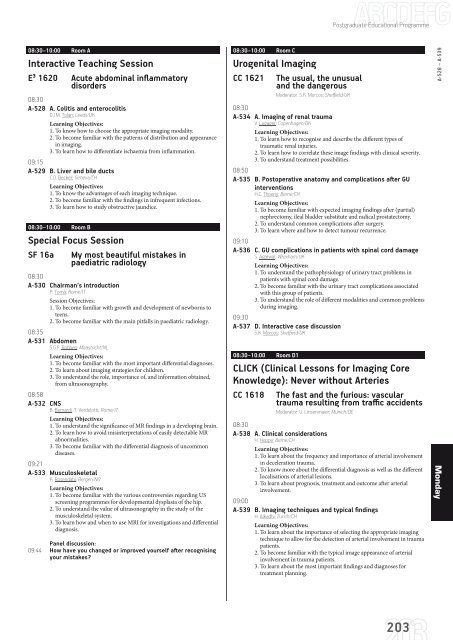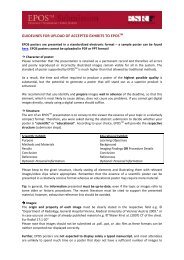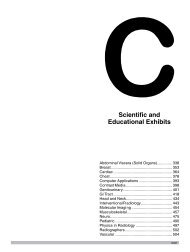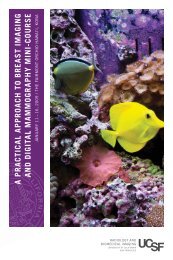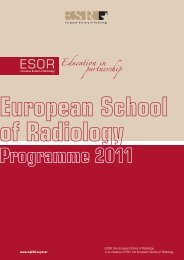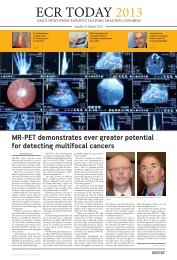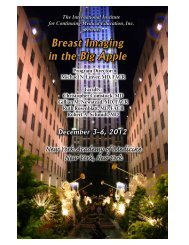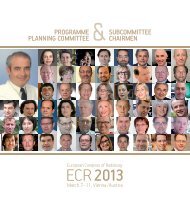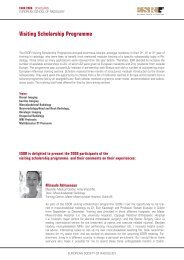ECR 2013 â Final Programme - myESR.org
ECR 2013 â Final Programme - myESR.org
ECR 2013 â Final Programme - myESR.org
- No tags were found...
Create successful ePaper yourself
Turn your PDF publications into a flip-book with our unique Google optimized e-Paper software.
Postgraduate Educational <strong>Programme</strong>08:30–10:00 Room AInteractive Teaching SessionE³ 1620 Acute abdominal inflammatorydisorders08:30A-528 A. Colitis and enterocolitisD.J.M. Tolan; Leeds/UKLearning Objectives:1. To know how to choose the appropriate imaging modality.2. To become familiar with the patterns of distribution and appearancein imaging.3. To learn how to differentiate ischaemia from inflammation.09:15A-529 B. Liver and bile ductsC.D. Becker; Geneva/CHLearning Objectives:1. To know the advantages of each imaging technique.2. To become familiar with the findings in infrequent infections.3. To learn how to study obstructive jaundice.08:30–10:00 Room BSpecial Focus SessionSF 16a My most beautiful mistakes inpaediatric radiology08:30A-530 Chairman‘s introductionP. Tomà; Rome/ITSession Objectives:1. To become familiar with growth and development of newborns toteens.2. To become familiar with the main pitfalls in paediatric radiology.08:35A-531 AbdomenS.G.F. Robben; Maastricht/NLLearning Objectives:1. To become familiar with the most important differential diagnoses.2. To learn about imaging strategies for children.3. To understand the role, importance of, and information obtained,from ultrasonography.08:58A-532 CNSB. Bernardi, T. Verdolotti; Rome/ITLearning Objectives:1. To understand the significance of MR findings in a developing brain.2. To learn how to avoid misinterpretations of easily detectable MRabnormalities.3. To become familiar with the differential diagnosis of uncommondiseases.09:21A-533 MusculoskeletalK. Rosendahl; Bergen/NOLearning Objectives:1. To become familiar with the various controversies regarding USscreening programmes for developmental dysplasia of the hip.2. To understand the value of ultrasonography in the study of themusculoskeletal system.3. To learn how and when to use MRI for investigations and differentialdiagnosis.Panel discussion:09:44 How have you changed or improved yourself after recognisingyour mistakes?08:30–10:00 Room CUrogenital ImagingCC 1621 The usual, the unusualand the dangerousModerator: S.K. Morcos; Sheffield/UK08:30A-534 A. Imaging of renal traumaV. Logager; Copenhagen/DKLearning Objectives:1. To learn how to recognise and describe the different types oftraumatic renal injuries.2. To learn how to correlate these image findings with clinical severity.3. To understand treatment possibilities.08:50A-535 B. Postoperative anatomy and complications after GUinterventionsH.C. Thoeny; Berne/CHLearning Objectives:1. To become familiar with expected imaging findings after (partial)nephrectomy, ileal bladder substitute and radical prostatectomy.2. To understand common complications after surgery.3. To learn where and how to detect tumour recurrence.09:10A-536 C. GU complications in patients with spinal cord damageS. Agarwal; Wrexham/UKLearning Objectives:1. To understand the pathophysiology of urinary tract problems inpatients with spinal cord damage.2. To become familiar with the urinary tract complications associatedwith this group of patients.3. To understand the role of different modalities and common problemsduring imaging.09:30A-537 D. Interactive case discussionS.K. Morcos; Sheffield/UK08:30–10:00 Room D1CLICK (Clinical Lessons for Imaging CoreKnowledge): Never without ArteriesCC 1618 The fast and the furious: vasculartrauma resulting from traffic accidentsModerator: U. Linsenmaier; Munich/DE08:30A-538 A. Clinical considerationsH. Hoppe; Berne/CHLearning Objectives:1. To learn about the frequency and importance of arterial involvementin deceleration trauma.2. To know more about the differential diagnosis as well as the differentlocalisations of arterial lesions.3. To learn about prognosis, treatment and outcome after arterialinvolvement.09:00A-539 B. Imaging techniques and typical findingsH. Alkadhi; Zurich/CHLearning Objectives:1. To learn about the importance of selecting the appropriate imagingtechnique to allow for the detection of arterial involvement in traumapatients.2. To become familiar with the typical image appearance of arterialinvolvement in trauma patients.3. To learn about the most important findings and diagnoses fortreatment planning.A-528 – A-539Monday203


